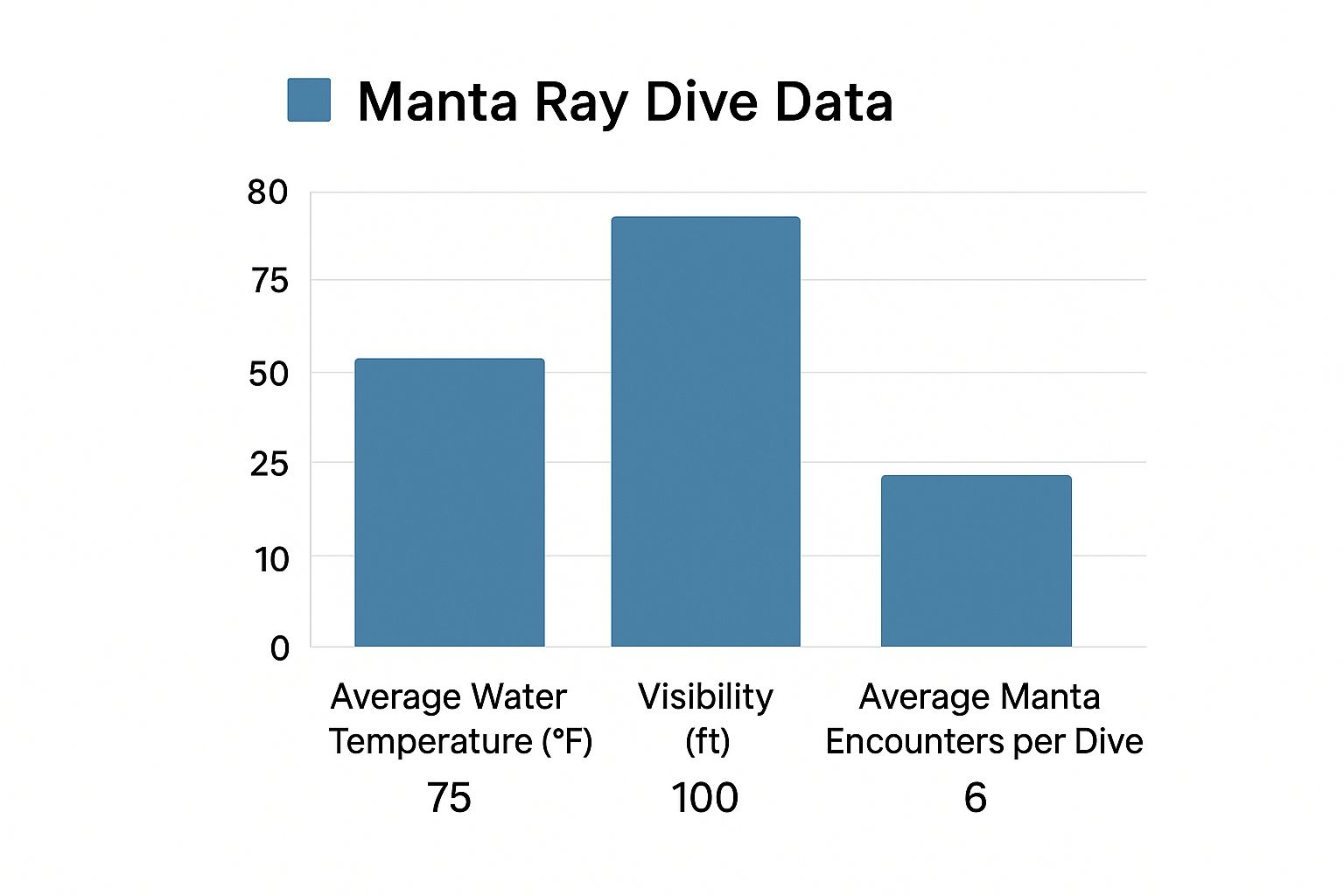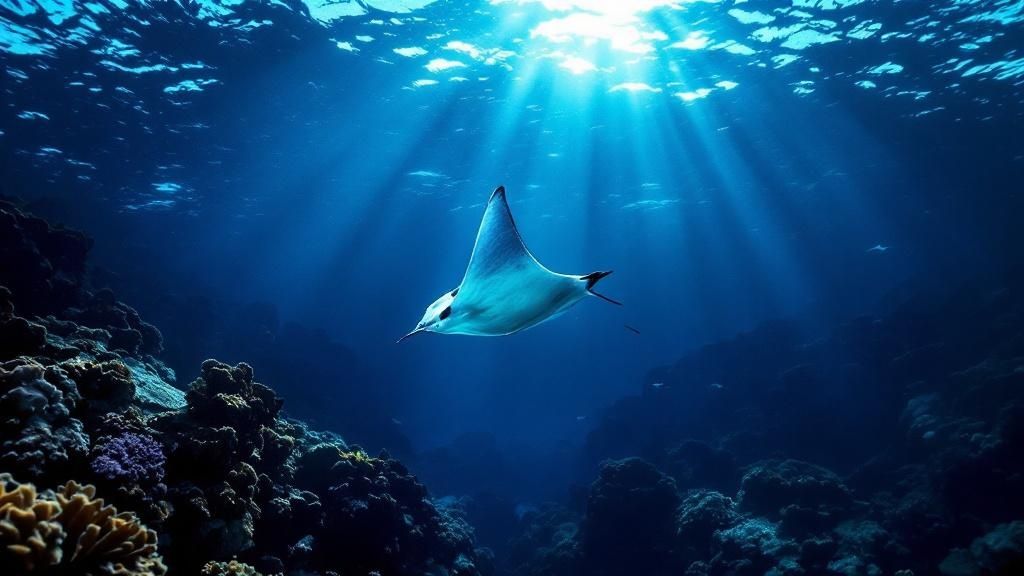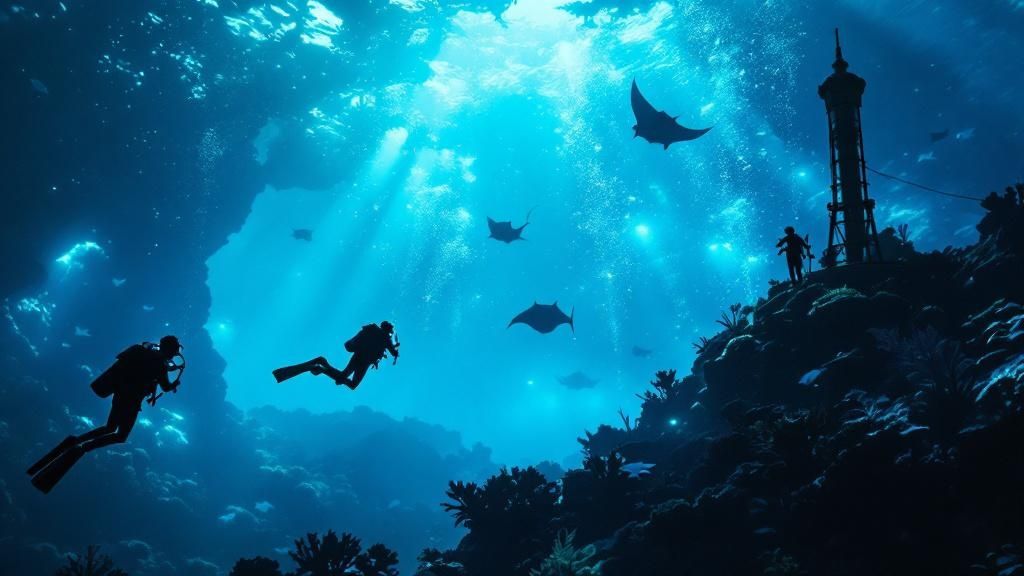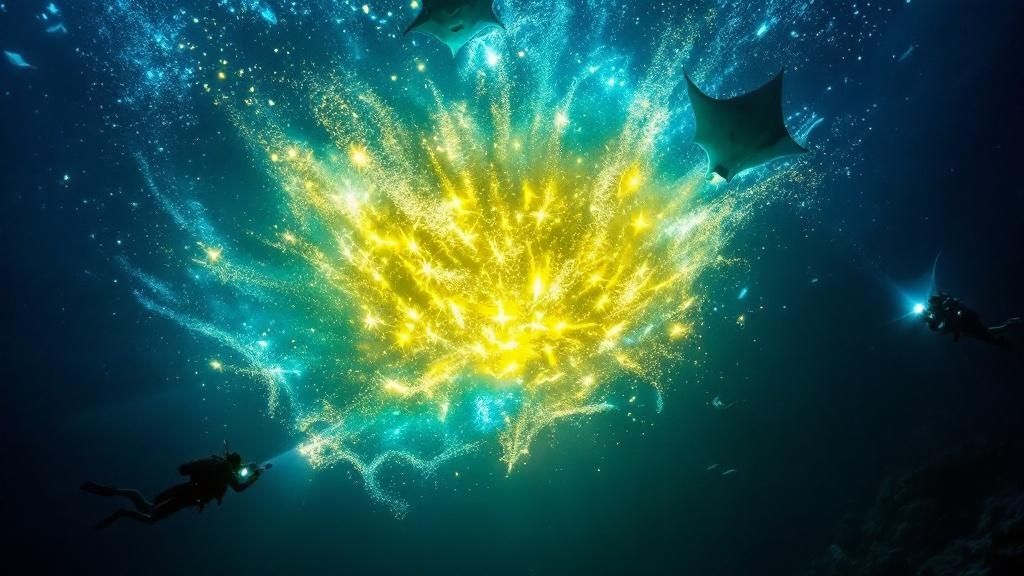Why Kona Reigns As The Ultimate Manta Ray Haven
Kailua Kona isn't just a picturesque Hawaiian escape; it's the global hotspot for manta ray encounters, attracting divers and snorkelers worldwide. What makes this location so special? It's a unique combination of natural elements that create the perfect environment for these gentle giants.
The Perfect Recipe for a Manta Ray Paradise
One key factor is the nutrient-rich waters surrounding Kona. Fueled by Pacific currents, these waters support thriving plankton blooms, the main food source for manta rays. This constant food supply is a major attraction for these graceful creatures. The volcanic landscape of the Kona coastline also plays a vital role. The sloping seabed and underwater lava formations create channels that funnel plankton towards the surface, providing a readily available feast for the mantas.
This readily available food, combined with the warm, clear waters, makes Kona a year-round manta ray paradise. The following infographic illustrates some key data about the average conditions for a manta ray night dive in Kailua Kona:

As the infographic demonstrates, the average water temperature of 75°F, visibility of 100 feet, and an average of 6 manta ray encounters per dive create truly unforgettable diving conditions. This combination ensures both comfortable diving and incredible chances for up-close encounters with these majestic animals. Remember to dive responsibly and learn about ways to help prevent marine pollution. You might also be interested in learning more about what a manta ray night dive is like.
A Sanctuary Built on Conservation
Decades of conservation work have solidified Kona's position as a manta ray sanctuary. These efforts have led to strict guidelines for manta ray interactions, making sure that tourism doesn't harm these animals. This dedication to sustainable tourism has helped protect the local manta ray population and contributes to the overall health of the marine ecosystem. For instance, local dive operators follow specific protocols for boat positioning, diver behavior, and lighting during night dives.
Unmatched Sighting Rates
Kona's Manta Ray Night Dive is world-famous for its incredibly high sighting rates. According to local dive operators and ongoing data collection, manta rays are typically seen on 85–90% of night dives year-round. Recent estimates suggest there are over 450 individual manta rays in the waters off Kailua-Kona, leading some operators to report sighting probabilities of over 95% on certain nights. Learn more about manta ray statistics. This remarkable consistency truly sets Kailua Kona apart as an exceptional location for manta ray encounters.
The following table provides a comparison of manta ray sighting success rates in Kailua Kona and other global destinations. It highlights the key factors that contribute to Kona's remarkable success in attracting and maintaining a healthy manta ray population.
Manta Ray Sighting Success Rates By Location
| Location | Average Sighting Rate | Best Season | Population Size |
|---|---|---|---|
| Kailua Kona, Hawaii | 85-95% | Year-round | 450+ |
| Yap, Micronesia | 70-80% | November-May | 200-300 (estimated) |
| Maldives | 60-70% | May-November | Variable, dependent on location |
| Socorro Islands, Mexico | 50-60% | November-May | Unknown |
As the table shows, Kailua Kona boasts significantly higher sighting rates compared to other popular manta ray destinations. The year-round presence of a large, stable population, combined with favorable environmental conditions, contributes to Kona's unmatched success in providing unforgettable manta ray experiences.
Inside The Magic: Your Complete Night Dive Experience
Picture this: the Kona sun dips below the horizon, painting the sky in vibrant shades of orange and purple. As the stars begin to emerge, you gear up for an extraordinary adventure: a manta ray night dive in Kailua Kona. This isn't just any dive; it's a rare glimpse into a hidden world, a breathtaking immersion into an underwater realm that few get to experience. From the moment you set sail under the starlit sky to the instant the first manta ray glides into view, the entire experience is simply magical.
From Boat to Ballet: The Unfolding Magic
Your journey begins with an exciting boat ride, filled with anticipation, to one of Kona's designated manta ray viewing areas. Popular spots include Manta Village and Manta Heaven. Once anchored, your guide will provide a thorough briefing on dive procedures and the proper etiquette for interacting with manta rays. As you descend into the dark depths, a specialized lighting system illuminates the ocean floor, transforming it into a mesmerizing underwater stage. These lights attract plankton, the manta ray's main food source, setting the scene for a spectacular show.
The Underwater Ballet Begins
Suddenly, out of the darkness, they appear: majestic manta rays with wingspans reaching up to 12 feet. These gentle giants gracefully glide through the illuminated water, engaging in a captivating underwater ballet. They perform impressive barrel rolls, execute perfectly synchronized movements, and display other intricate maneuvers as they feast on the plankton. Often, these incredible creatures come within inches of the divers, offering a truly up-close and personal encounter that leaves many speechless.
Dive Details and Manta Ray Marvels
Typical manta ray night dives in Kailua Kona take place at depths of 30-40 feet and last approximately 45-60 minutes. During this time, you'll have the opportunity to witness incredible feeding behaviors. Mantas often perform what’s called a "barrel roll," a circular feeding technique where they loop repeatedly through the plankton-rich water. You might also observe "chain feeding," where multiple mantas line up to filter-feed through the same area. Historical tracking of the Kailua-Kona manta ray population has revealed remarkable longevity and site fidelity. Since researchers began systematic monitoring in the 1990s, individual mantas like 'Big Bertha' have been documented returning to the area year after year, demonstrating decades-long residency. Learn more about manta ray residency. You might also be interested in why you should go on a manta ray dive in Kona.
A Symphony of Senses: Beyond the Visuals
The magic of a manta ray night dive extends far beyond just the visuals. The gentle whooshing sound of the mantas as they glide through the water, the coolness of the ocean against your skin, and the shared excitement among the divers all combine to create a truly immersive sensory experience. This is why this unique adventure is consistently ranked among the world's top wildlife encounters.

The Unforgettable Takeaway
The manta ray night dive in Kailua Kona is more than just a dive; it's an unforgettable adventure that combines the wonder of nature, the marvels of science, and a sense of pure awe. It's a unique opportunity to connect with the natural world on a deeper level, creating memories that will stay with you forever.
Smart Preparation For An Unforgettable Encounter
Success on a manta ray night dive in Kailua Kona begins well before you hit the water. Careful planning, from ensuring you're physically prepared to understanding night diving conditions, is what separates confident divers from the rest. This section covers the key elements to make the most of your manta ray experience.
Gear Up: Essentials for an Enhanced Experience
The right gear significantly improves your comfort and safety, allowing you to truly appreciate the magic happening around you. Here's a checklist of must-have items:
- Wetsuit: Although Kona's waters are usually warm, a wetsuit (3mm for summer, 5mm for winter) provides extra warmth, particularly at night. Water shoes will protect your feet on the boat and during entry and exit.
- Underwater Camera: A GoPro or similar waterproof camera with good low-light performance is perfect for capturing the encounter. Make sure you test it beforehand!
- Towel and Dry Clothes: There's nothing quite like the feeling of dry clothes after a dive.
- Seasickness Remedies: If you are susceptible to seasickness, take precautions like Dramamine or acupressure bands. Safety is paramount in any water activity. Check out these snorkeling safety tips for more guidance.
Fitness and Skills: Ensuring a Comfortable and Safe Dive
While manta ray night dives are generally suitable for most experience levels, a certain level of fitness and swimming ability will contribute to a safer and more enjoyable dive.
- Comfortable Swimming: You should be a strong swimmer and feel at ease in open water.
- Basic Dive Skills: For scuba diving, certification is required. It’s a good idea to brush up on your skills if you haven’t dived recently. Take a look at our guide on what to know about manta ray dives in Kona.
- Buddy System Proficiency: Familiarize yourself with buddy system procedures to enhance your safety.
Mental Preparation: Staying Calm and Focused
Mental preparation is just as crucial as physical readiness. Here’s how to ensure you’re in the best frame of mind:
- Pre-Dive Relaxation Techniques: Try deep breathing exercises to manage any pre-dive nerves.
- Visualize the Experience: Picture yourself calmly observing the manta rays. This can build positive anticipation and reduce anxiety.
- Review Safety Procedures: Familiarize yourself with emergency procedures relating to night diving and manta ray encounters. This will increase your confidence in the water.
Respecting the Gentle Giants: Interaction Etiquette
Responsible interactions are vital for the health of these incredible creatures. Observe these guidelines:
- Maintain Distance: Never touch the manta rays. Their protective mucous layer is essential to their well-being.
- No Flash Photography: Flash can disorient and upset them.
- Follow Your Guide's Instructions: Pay close attention to instructions on safe interaction practices.
- Controlled Movements: Avoid sudden movements or excessive splashing, as this can disturb the mantas.

By following these preparation tips, you'll embark on your manta ray night dive in Kailua Kona with confidence and respect, ready to embrace this unforgettable experience. This preparation isn't simply about safety—it's about making the most of every moment with these gentle giants.
Choosing Your Perfect Manta Ray Adventure
Not all manta ray tour operators in Kailua Kona are created equal. Your choice significantly impacts your experience, from the encounter's quality to supporting ongoing conservation efforts. This guide helps you select the right operator for your manta ray night dive in Kailua Kona, emphasizing safety, conservation, and expertise.
Key Considerations: Beyond the Basics
When choosing a manta ray dive operator, prioritize safety records and commitment to conservation. Inquire about their adherence to established interaction guidelines and contributions to local research and preservation initiatives. The operator's genuine expertise is also crucial.
Experienced guides who understand manta ray behavior enhance your experience. They can anticipate the animals' movements and ensure respectful interactions. This knowledge adds another layer of enjoyment to your dive.
Decoding Tour Packages: What to Look For
Different tour packages cater to various needs and budgets. Understanding what each package includes helps you select the best fit. Consider these factors:
- Group Size: Smaller groups (2-6 people) often provide a more personalized experience. Larger boats (10-20+ people) may be more budget-friendly.
- Amenities: Premium tours might include specialized photography services, high-quality equipment rentals, and refreshments.
- Dive Site Selection: Experienced operators choose dive sites based on current conditions and manta ray activity, optimizing your chances of a memorable encounter.
The Importance of Ethical Practices
The best manta ray tour operators adhere to strict guidelines for interacting with these gentle giants. These often include maintaining a safe distance, avoiding touch, and refraining from flash photography.
These practices ensure the manta rays' well-being and contribute to the population's long-term health. Your choice of operator directly impacts these conservation efforts. Supporting operators committed to sustainable practices reinforces responsible tourism and protects this unique ecosystem.
Red Flags: When to Look Elsewhere
Some red flags should prompt you to consider other operators. Be wary of those who:
- Guarantee Sightings: While Kona has high sighting rates, no reputable operator can guarantee an encounter.
- Disregard Interaction Guidelines: Touching manta rays or disrupting their natural behavior is unacceptable and harmful.
- Lack Proper Safety Procedures: Prioritize operators with a strong commitment to safety protocols and emergency preparedness.
Choosing Wisely: Insights from Experienced Divers
Experienced divers often prioritize operators with a deep understanding of the local environment and a proven commitment to conservation. They know a truly memorable experience prioritizes both the thrill of the encounter and the protection of these incredible creatures.
Experienced divers also value operators who emphasize education. They provide insights into manta ray behavior and their importance in the marine ecosystem. This adds depth and meaning to the experience, making it more than just a dive.

To help you choose the best operator, we've compiled a comparison guide outlining key features and price ranges.
Dive Operator Comparison Guide: Key factors to consider when choosing a manta ray night dive operator in Kailua Kona
| Operator Features | Budget Option | Mid-Range | Premium Experience |
|---|---|---|---|
| Group Size | Larger (10-20+) | Medium (6-12) | Small (2-6) |
| Amenities | Basic snacks and drinks | Hot beverages, upgraded snacks | Gourmet meals, personalized service |
| Photography Services | Not included | Available for an extra fee | Professional photographer onboard |
| Dive Site Selection | Standard locations | Flexible based on conditions | Exclusive, less crowded sites |
| Price Range | $100-$150 | $150-$250 | $250+ |
This table summarizes the key differences between budget, mid-range, and premium manta ray dive operators. As you can see, the premium experience offers smaller groups, exclusive amenities, and specialized services, while the budget option provides a more basic experience.
By carefully considering these factors and asking the right questions, you can choose the perfect operator for your manta ray night dive in Kailua Kona. This ensures a safe, rewarding, and ethical experience that you'll cherish for years to come.
Timing Your Visit For Maximum Magic
Smart timing can significantly enhance your manta ray night dive experience in Kailua Kona. By understanding the combined effects of seasonal patterns, moon phases, and ocean currents, you can optimize both manta ray activity and overall dive conditions. Let's explore the secrets to planning the perfect manta ray encounter.
Moon Phases: Illuminating the Underwater Ballet
Moon phases play a significant role in both visibility and manta ray behavior. During a new moon, the absence of moonlight makes the dive lights used to attract plankton even more effective. This creates a concentrated feeding area, bringing the manta rays closer to the surface for spectacular viewing. Even during a full moon, the specialized dive lights still attract plenty of plankton, ensuring a captivating display.
Seasonal Variations: Calm Seas and Clear Waters
Manta rays grace Kailua Kona's waters year-round. However, the period from April to October typically offers calmer seas and improved visibility. This creates a more comfortable and enjoyable dive, particularly for those new to night diving or snorkeling. For a deeper dive into seasonal variations, check out this article: What is the best time of year to see manta rays in Kona?
Even during the winter months (November to March), manta ray encounters are definitely possible. While increased winds and rougher seas may occasionally lead to cancellations, especially between January and mid-March, experienced operators diligently monitor weather patterns and often reschedule dives for optimal conditions.
Ocean Currents: The Plankton Pipeline
Ocean currents are fundamental to the Kona ecosystem, directly affecting plankton distribution. These currents, combined with the volcanic slopes and sheltered bays, create concentrated pockets of plankton. These plankton-rich areas become reliable feeding grounds for manta rays, making Kailua Kona a consistently rewarding location for sightings.
Maximizing Your Chances: Flexibility and Real-Time Data
A flexible schedule greatly increases your chances of ideal conditions. Being open to adjusting your dive date based on weather forecasts and real-time data from experienced operators maximizes your opportunity for a memorable experience. Many operators utilize up-to-the-minute information on ocean currents and plankton activity to identify the most promising dive sites.
The Best Time of Evening: Prime Time for Manta Activity
Manta ray activity typically peaks during the first hour after sunset. This is prime time for plankton to rise to the surface, creating a feeding frenzy that draws these gentle giants. While activity may decrease as the night progresses, manta rays can still be observed throughout the night. Arriving at the dive site shortly after sunset increases your chances of witnessing the most impressive feeding displays.
Planning Your Hawaiian Getaway: Centered Around Manta Magic
Building your Hawaiian vacation around this incredible experience is a worthwhile endeavor. Consider booking accommodation in Kailua Kona to maximize your time and minimize travel. Numerous resorts and hotels offer easy access to manta ray dive operators. Booking your dive earlier in your trip allows for rescheduling flexibility in case of inclement weather. This ensures you don’t miss this unique opportunity. By following these tips, you'll be well-prepared for a truly magical manta ray night dive in Kailua Kona. The combination of optimal timing, experienced operators, and a bit of flexibility can elevate a good dive into a truly legendary one.
Conservation Through Responsible Adventure Tourism
Your manta ray night dive in Kailua Kona isn't just a personal thrill; it's a direct contribution to marine conservation. Responsible tourism like this funds vital research, habitat protection, and community education, ensuring these magnificent creatures flourish for generations.
How Your Dive Makes a Difference
Every responsible manta ray night dive contributes to the larger mission of marine stewardship. The fees you pay to ethical tour operators often directly support local research initiatives. This research helps scientists understand manta ray behavior, migration patterns, and population dynamics, providing crucial data for effective conservation strategies.
Responsible tourism also promotes habitat protection. By choosing operators committed to sustainable practices, you’re supporting businesses that prioritize minimizing their environmental impact and advocating for the preservation of manta ray habitats.
Protecting Manta Rays Through Interaction Guidelines
Responsible manta ray encounters rely on strict interaction guidelines that protect the animals while ensuring an authentic visitor experience. These guidelines are based on a scientific understanding of manta ray behavior and vulnerability. For example, touching manta rays is prohibited as it can damage their delicate mucous layer, which protects them from infection.
Flash photography is also discouraged as it can disorient and stress the animals. Check out our guide on Manta Ray Dive/Snorkel Interaction Guidelines.
Supporting Local Communities and Global Conservation
Manta ray tourism provides vital economic support for local communities. By choosing local operators, you contribute to the local economy and create jobs that depend on the health of the manta ray population. This fosters a sense of shared responsibility for conservation.
Furthermore, research and conservation efforts supported by manta ray tourism in Kailua Kona often have global implications. The data collected and the best practices developed here can inform conservation strategies for manta ray populations worldwide.
The Kona Success Story: A Model of Sustainable Tourism
The thriving manta ray population in Kona is a testament to the success of a sustainable tourism model. Decades of collaborative efforts between researchers, tour operators, and the local community have created a balance between tourism and protection. This collaborative approach has not only protected the manta rays but has also created a thriving ecotourism industry. By choosing ethical operators committed to these principles, you help maintain this balance.
The Power of Choice: Ethical Operators and Conservation
Choosing an ethical operator is crucial for responsible manta ray tourism. Look for operators who:
- Actively participate in research and conservation initiatives: This might include financial contributions to research organizations or participation in data collection.
- Strictly adhere to interaction guidelines: They should prioritize the well-being of the manta rays.
- Educate their guests about manta ray biology and conservation: A good operator will enhance your experience by teaching you about these animals and the importance of protecting them.
- Minimize their environmental footprint: This can include using fuel-efficient boats and reducing waste.
By carefully selecting your tour operator, you ensure your manta ray night dive contributes to the long-term health and survival of these amazing creatures. This is the heart of responsible adventure tourism: experiencing the wonder of the natural world while actively contributing to its preservation.
Book Your Manta Ray Night Dive Adventure with Kona Honu Divers
Ready to experience the magic of a manta ray night dive in Kailua Kona and contribute to their conservation? Book your unforgettable adventure with Kona Honu Divers today! We are committed to sustainable practices and providing an exceptional experience that respects these gentle giants and their environment.
